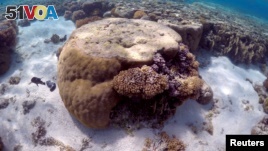01 April, 2016
Australia's National Coral Bleaching Task force says the country's Great Barrier Reef is facing the "worst mass bleaching event in its history."
The reef is a United Nations Educational Scientific and Cultural Organization World Heritage site. It has more than 400 species of coral and 1,500 kinds of fish. It is the only reef that is a Heritage site, a place that is named by UNESCO as having special cultural or physical significance.
The reef is along the northeastern coast of Australia. It is three quarters the size of the western American state of California.
Bleaching happens when sea temperatures rise. Higher temperatures cause the coral to force out colorful algae. The coral becomes white.

A large piece of coral can be seen in the lagoon located on Lady Elliot Island and 80 kilometers north-east from the town of Bundaberg in Queensland, Australia, June 9, 2015.
If the water temperature falls, the process could reverse. Algae could return to the coral. If it does not, the coral could die.
Researchers examined aerial surveys of more than 500 reefs north of the city of Cairns. The researchers said most of the reefs suffered from severe bleaching.
Terry Hughes leads the National Coral Bleaching Taskforce.
He said "this has been the saddest research trip of my life."
"We flew for 4,000 kilometers in the most pristine parts of the Great Barrier Reef and saw only four reefs that had no bleaching. The severity is much greater than in earlier bleaching events in 2002 or 1998," he said.
Hughes also said "it's still too early to tell just what the overall outcome will be. We will continue to conduct underwater surveys along the Great Barrier Reef in the coming months as the full impact of this mass bleaching event unfolds."
Hughes said the most of the severe bleaching was in the northern part of the reef. He says the southern part was not as affected because of "cloudy weather that cooled the water temperatures."
He said the bleaching was likely made worse by the strong El Niño event in the Pacific Ocean. The Washington Post reports there have been three recorded mass bleaching events -- in 1998, 2010 and this year. All three took place at the same time as the El Niño event.
I'm Ashley Thompson.
VOANews.com reported this story. Christopher Jones-Cruise adapted the report for VOA Learning English. Kathleen Struck was the editor.
We want to hear from you. Write to us in the Comments Section, or visit 51VOA.COM.
_____________________________________________________________
Words in This Story
species – n. a group of animals or plants that are similar and can produce young animals or plants; a group of related animals or plants that is smaller than a genus
coral – n. a hard material formed on the bottom of the sea by the skeletons of small creatures
algae – n. simple plants that have no leaves or stems and that grow in or near water
aerial – adj. taken or seen from an airplane
pristine – adj. not changed by people; left in its natural state
survey – n. an act of studying something so as to be able to make a judgment about it
unfold – v. to happen as time passes